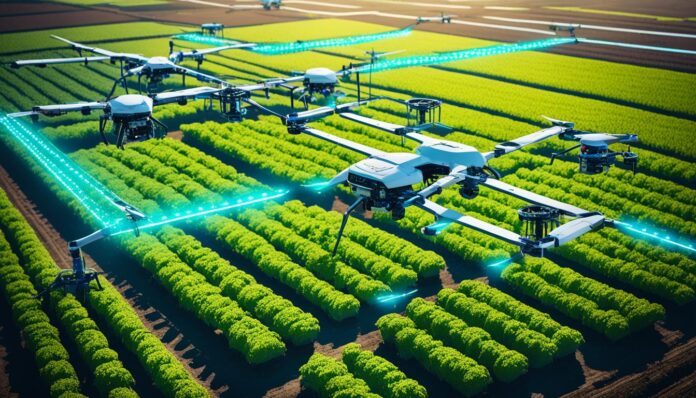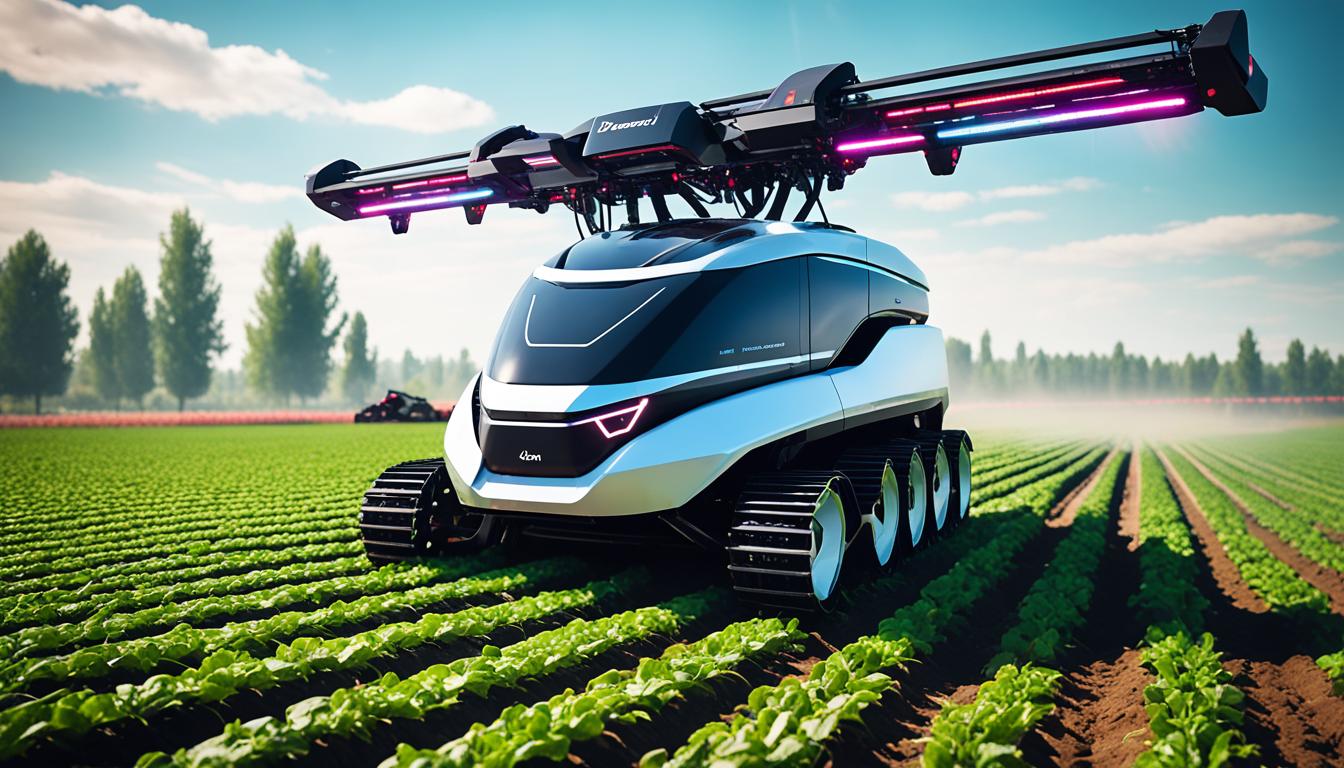
Prepare to witness a revolution in the way you farm, as Artificial Intelligence (AI) revolutionizes the agricultural industry. The AI in agriculture market is expected to grow exponentially, reaching a global worth of $2.6 billion by 2025, a 22.5% increase from 2017. This cutting-edge technology is transforming the industry, addressing challenges like rising costs, labor shortages, and consumer demand for transparency and sustainability.
From indoor vertical farming and livestock technology to precision agriculture and blockchain-powered food traceability, AI is driving efficiency, productivity, and sustainability in modern farming practices. By 2025, you’ll see the widespread adoption of AI-powered autonomous machinery, predictive analytics, and data-driven decision-making, reshaping the way you approach every aspect of your farming operations.
Key Takeaways
- AI is revolutionizing agriculture, enabling precision farming, predictive analytics, and autonomous equipment.
- The AI in agriculture market is expected to grow exponentially, reaching a global worth of $2.6 billion by 2025.
- AI is addressing challenges like rising costs, labor shortages, and consumer demand for transparency and sustainability.
- AI is driving efficiency, productivity, and sustainability in modern farming practices, from vertical farming to precision agriculture.
- By 2025, you’ll see widespread adoption of AI-powered autonomous machinery, predictive analytics, and data-driven decision-making in agriculture.
AI-Driven Efficiency and Sustainability in Agriculture
The integration of autonomous machinery, agricultural robotics, and precision agriculture tools powered by data analytics is revolutionizing modern farming practices. These AI-driven technologies are not only increasing productivity but also promoting sustainable agriculture practices that address critical challenges, such as water conservation and climate resilience.
Autonomous Machinery and Robotics
AI-powered autonomous machinery and robotics are increasing productivity by up to 15% and reducing herbicide use by 90%. Industry leaders like John Deere and Trimble are harnessing these advanced technologies to optimize planting patterns, reduce fuel and seed costs by 20%, and automate numerous farming tasks with greater efficiency.
Precision Agriculture and Data Analytics
Precision agriculture tools, such as the DJI Agras T20 drones, can spray up to 12 hectares per hour, cutting water usage by 50%. By leveraging the power of data analytics, farmers can make more informed, data-driven decisions to enhance productivity and sustainability across their operations.
Water Conservation with AI
Water conservation is a major focus in the age of climate change, and AI-powered systems are playing a crucial role. Solutions like WiseConn’s DropControl can reduce water usage by 30% across 50,000 acres, while Netafim’s drip irrigation technology saves 40 billion gallons of water annually. Furthermore, partnerships between companies like Agritecture, Asahi, and Microsoft are using AI to improve drought resilience for farmers, such as the case with Czech hops growers.

How will the use of AI in agriculture change farming practices by 2025?
The integration of big data and predictive analytics in agriculture is revolutionizing farming practices. IBM Watson has demonstrated the power of AI by increasing crop yields by an impressive 25%. SAP’s Connected Agriculture platform is also streamlining the agricultural supply chain through data-driven insights. Advanced AI-powered models can now detect potential diseases with up to 98% accuracy, allowing farmers to take proactive measures and mitigate the impact of crop diseases.
Big Data and Predictive Analytics
As farms become more digitized and data-driven, the global market for big data in agriculture is expected to reach billions by 2027. Sophisticated predictive analytics models are enabling farmers to make more informed, data-driven decisions that optimize resource allocation, boost productivity, and enhance sustainability. The Nature Conservancy, for instance, is harnessing remote sensing data and AI to optimize conservation planning and climate-smart agriculture practices.
Early Disease Detection
AI-powered models are revolutionizing early disease detection in agriculture, allowing for proactive management and mitigation. By analyzing data from various sources, including satellite imagery, IoT sensors, and historical records, these models can predict potential disease outbreaks with remarkable accuracy. This empowers farmers to take preventive measures, safeguarding their crops and minimizing losses.
Global Impact and Adoption
The impact of AI in agriculture is being felt worldwide, as innovative initiatives are democratizing access to cutting-edge technology. CropIn in India and UjuziKilimo in Africa are using big data and AI to enhance food security and improve the lives of smallholder farmers. These global efforts are paving the way for a more sustainable, data-driven future in agriculture, where precision farming and climate-smart practices become the norm.
Conclusion
The integration of AI in agriculture is reshaping farming practices, driving efficiency, sustainability, and global impact. However, this revolution also presents challenges, such as job displacement and the need for reskilling, as well as ethical concerns around data privacy. Bridging the skill gap and addressing these issues will be crucial as AI continues to transform the agricultural industry by 2025 and beyond.
Collaboration between tech companies, governments, and farming communities will be key to unlocking the full potential of AI in agriculture and ensuring a sustainable, data-driven future for farming. As AI continues to disrupt traditional farming methods, it’s essential that we work together to navigate the challenges and harness the power of this technology to create a more efficient, environmentally conscious, and globally impactful agricultural system.
The future of farming is undoubtedly intertwined with the advancements in AI. By embracing this transformative technology, you can unlock new levels of productivity, sustainability, and global impact, shaping the industry for generations to come.
FAQ
How will the use of AI in agriculture change farming practices by 2025?
The use of AI in agriculture is revolutionizing farming practices by enabling precision farming, predictive analytics, and autonomous equipment. By 2025, you can expect AI to drive efficiency, productivity, and sustainability across modern farming operations.
How will AI-powered autonomous machinery and robotics impact agriculture?
AI-powered autonomous machinery and robotics are increasing productivity by up to 15% and reducing herbicide use by 90%. Companies like John Deere and Trimble are harnessing these technologies to optimize planting patterns and reduce fuel and seed costs by 20%.
How is AI being used to improve precision agriculture and data analytics?
Precision agriculture tools like DJI Agras T20 drones can spray 12 hectares per hour, cutting water usage by 50%. Big data and AI are also revolutionizing agriculture, with IBM Watson increasing crop yields by 25% and SAP’s Connected Agriculture streamlining the supply chain.
How is AI being used to conserve water in agriculture?
Water conservation is a major focus, with systems like WiseConn’s DropControl reducing water usage by 30% across 50,000 acres, and Netafim’s drip irrigation saving 40 billion gallons annually.
How is AI being used to detect diseases and pests in agriculture?
AI-powered models can detect potential diseases with up to 98% accuracy, allowing for proactive management. The global market for big data in agriculture is expected to reach billions by 2027, as farms become more digitized and data-driven.
How is AI supporting global initiatives for sustainable agriculture practices?
Global initiatives, such as CropIn in India and UjuziKilimo in Africa, are using big data and AI to democratize access to cutting-edge technology and enhance food security worldwide. The Nature Conservancy is also using remote sensing and AI to optimize conservation planning.
